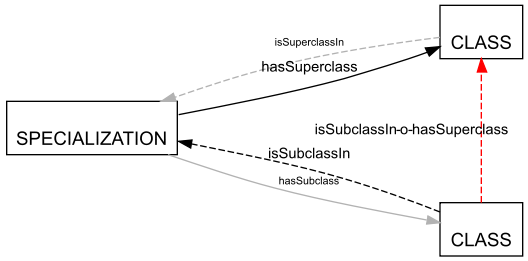TracNav menu
ISO 15926-2 in OWL
This page lists and describes the different available OWL representations of various parts of ISO 15926-2.
Contents
- ISO 15926-2:2003 entity types
- ISO 15926-2:2003 definitions, examples and notes
- ISO 15926-2:2003 membership relationships
- ISO 15926-2:2003 inverse roles
- ISO 15926-2:2003 chained roles
- OWL list
- Dependence diagram
ISO 15926-2:2003 entity types
The file http://rds.posccaesar.org/2008/02/OWL/ISO-15926-2_2003 contains all the entity types defined in ISO 15926-2:2003 represented as owl:classes. The file is generated by translating the EXPRESS file lifecycle_integration_schema.exp downloaded from http://www.tc184-sc4.org/EXPRESS/ which ISO 15926-2 (2003) annex B references, to an XML serialization of OWL. A more thorough description of the translation is found in the article ISO15926inOWLtranslateEXPRESStoOWL.
This ontology is represented in the OWL sublanguage OWL DL and has the DL expressivity  , this is partly because the ontology imports the OWL linked list representation.
, this is partly because the ontology imports the OWL linked list representation.
ISO 15926-2:2003 definitions, examples and notes
The file http://rds.posccaesar.org/2008/07/OWL/ISO-15926-2_2003_annotations contains definitions, examples and notes of the ISO 15926-2:2003 entity types. The file is generated by transforming a version of the EXPRESS file lifecycle_integration_schema.exp containing this information in comments. This EXPRESS file is not "ISO official", so there is no guarantee of the correctness of the content. There is a ISO published online version of ISO 15926-2:2003, please report back if you find errors in our OWL representations.
This ontology is represented in the OWL sublanguage OWL DL and has the DL expressivity  . This complexity is completely due to the complexity of 2008/02/OWL/ISO-15926-2_2003 which this file imports. All definitions, examples and notes are represented using owl:AnnotationProperty which have no effect on the DL expressiveness of an OWL ontology.
. This complexity is completely due to the complexity of 2008/02/OWL/ISO-15926-2_2003 which this file imports. All definitions, examples and notes are represented using owl:AnnotationProperty which have no effect on the DL expressiveness of an OWL ontology.
ISO 15926-2:2003 membership relationships
The file http://rds.posccaesar.org/2008/07/OWL/ISO-15926-2_2003_entityMembership contains membership relationships between the entity types of ISO 15926-2:2003. These relationships are expressed after an interpretation of the text definitions of the entity types of ISO 15926-2:2003; a discussion on this work is found on the wiki page Adding membership relationships to ISO 15926-2 in OWL.
The file http://rds.posccaesar.org/2008/07/OWL/ISO-15926-2_2003_entityMembershipCandidates contains candidate membership relationships. See the above mentioned wiki page for more information.

Figure 1: The owl:Class Classification, the owl:ObjectPropertys
hasClassifier and hasClassified (in grey) -- and their inverse
owl:ObjectPropertys isClassifierIn and isClassifiedIn (in red) respectively.
ISO 15926-2:2003 inverse roles
The file http://rds.posccaesar.org/2008/09/OWL/ISO-15926-2_2003_inverseRoles defines the inverse owl:ObjectProperty of all the owl:ObjectPropertys defined in http://rds.posccaesar.org/2008/02/OWL/ISO-15926-2_2003. The naming convention is that the inverse property of hasX is named isXIn.
Example: The owl:ObjectPropertys hasClassifier and hasClassified are defined in ISO-15926-2_2003 as
ObjectProperty: hasClassifier Domain: Classification Class: Classification SubClassOf: hasClassifier exactly 1 Classi.e., the domain of hasClassifier is Classification and the range of hasClassifier, set locally on the owl:Class Classification, is Class. isClassifierIn, the inverse property of hasClassifer, is then an owl:ObjectProperty with Classification as range and Class as domain. See Figure 1.

Figure 2: The owl:Class Specialization, the owl:ObjectPropertys hasSubclass
and hasSuperclass (solid line), their inverse owl:ObjectPropertys isSubclassIn
and isSuperclassIn (dashed line) respectively -- and the owl:propertychain
isSubclassIn-o-hasSuperclass (in red).
ISO 15926-2:2003 chained roles
The file http://rds.posccaesar.org/2008/09/OWL/ISO-15926-2_2003_chainedRoles defines a series of owl:propertyChains. Property chains are the "owl-equvialent" to the mathematical composition of relations. Note: `owl:propertyChain` is a OWL 2 construct, so this file is not OWL DL.
The (binary) relations defined in ISO-15926 are reified, meaning that they are represented as entities with two attributes, e.g., the COMPOSITION_OF_INDIVIDUAL entity has two attributes: part and whole. In OWL the common way of representing relations is by means of binary properties, e.g., hasPart having "wholes" as domain and "parts" as range. This is equivalent to a binary logical predicate  which is true only if
which is true only if  is a part of
is a part of  . The property chain construct in OWL allows for an elegant definition of the more "OWL friendly" binary properties from the reified relations.
. The property chain construct in OWL allows for an elegant definition of the more "OWL friendly" binary properties from the reified relations.
Example: Specializations of classes in ISO 15926 are represented using the reified entity SPECIALIZATION. SPECIALIZATION has two attributes subclass and superclass. In the OWL representation of ISO 15926-2 this becomes the owl:Class Specialization and two owl:ObjectPropertys hasSubclass and hasSuperclass where the domain of the two properties is the class Specialization. (Read more on the OWL representation here). In OWL specialization is represented using rdsf:subClassOf. This relation can be mimiced by a property chain of isSubclassIn (the inverse property of hasSubclass) and hasSuperclass. This property chain is defined in ISO-15926-2_2003_chainedRoles and is called isSubclassIn-o-hasSuperclass. See Figure 2 for an illustration of this example.
OWL list
The OWL list ontology defines a set of entities used to describe the OWL list pattern written by Nick Drummond et al, see http://owl-workshop.man.ac.uk/acceptedLong/submission_12.pdf
This ontology is represented in the OWL sublanguage OWL DL and has the DL expressivity  .
.
Dependence diagram
The following diagram displays the dependencies and relationships between the ontologies listed on this page.

Attachments
- ISO15926inOWL_2.gif (34.4 kB) - added by margs 16 years ago.
